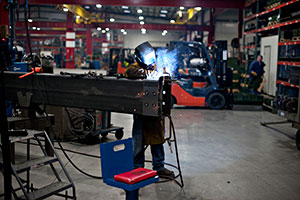Industrial Output Falls in October

Industrial production in the U.S. dropped in October, weighed down by declines at utilities, mines and automakers that signal manufacturing started the fourth quarter on soft footing.
Output fell 0.1% after a 0.8% increase in September that was smaller than previously estimated, figures from the Federal Reserve in Washington showed. The median forecast in a Bloomberg survey of 83 economists projected a 0.2% gain. Factory production rose 0.2%, matching the prior month’s advance that was also revised down.
A pickup in manufacturing is needed to help bolster the expansion, now is its sixth year, as global growth from Europe and Japan to emerging markets cools. Rising consumer confidence and the drop in gasoline prices are brightening the outlook for holiday sales, indicating factories will get a lift in the next few months.
“With the big print in September, you need a little bit of payback,” said Guy LeBas, chief fixed-income strategist at Janney Montgomery Scott LLC in Philadelphia, who correctly projected the decline in production.
Estimates for total industrial production in the Bloomberg survey ranged from a drop of 0.2% to a 0.6% gain after a previously reported September advance of 1%.
Manufacturing, which makes up 75% of total production, was forecast to increase 0.2%, according to the survey median.
The output of motor vehicles and parts decreased 1.2% in October, a third consecutive decline, today’s report showed. Excluding autos and parts, manufacturing rose 0.2%.
While industry data earlier this month that is used to calculate gross domestic product showed little change in demand for the prior month, Ford Motor Co., Toyota Motor Corp., Fiat Chrysler Automobiles NV and Nissan Motor Co. exceeded analysts’ estimates as buyers emboldened by falling gasoline prices flocked to sport-utility vehicles.
Automakers remain upbeat about the outlook for the economy and consumer.
“Consumer confidence has risen above its recent range in the past two month’s readings and falling commodity prices represent an additional financial windfall for consumers,” Ford Chief Economist Emily Kolinski Morris said on a Nov. 3 conference call. “Manufacturing indicators remain robust, and labor market indicators continue to show signs of steady though modest improvement.”
Other areas showed gains last month, pointing to sustained advances in U.S. corporate spending. Business-equipment production increased 0.6% after a 0.4% drop in September. Output of machinery climbed as demand grew for computers and electronics.
Consumer goods production fell 0.2% last month, led by the decline in autos.
Today’s report showed utility output decreased 0.7% last month after surging 4.2%. The average temperature in the contiguous U.S. last month was 57.1 degrees Fahrenheit (13.9 Celsius), making it the fourth-warmest October in the 120-year period of record keeping, according to data from the National Oceanic and Atmospheric Administration.
Mining production, which includes oil drilling, dropped 0.9% last month, the most in a year.
Capacity utilization, which measures the amount of a factory that is in use, declined to 78.9% in October from 79.2% the month before.
The report compares with data from the Institute for Supply Management that showed manufacturing advanced last month at a faster pace. The group’s factory index increased to 59 in October, matching August as the highest since March 2011, after 56.6 the prior month.
The economy may grow at a 2.6% clip in the fourth quarter after expanding 3.5% in the three months ended September, according to the median forecast in a Bloomberg survey of economists. Gains in business and consumer spending will be needed to sustain momentum heading into the new year.

